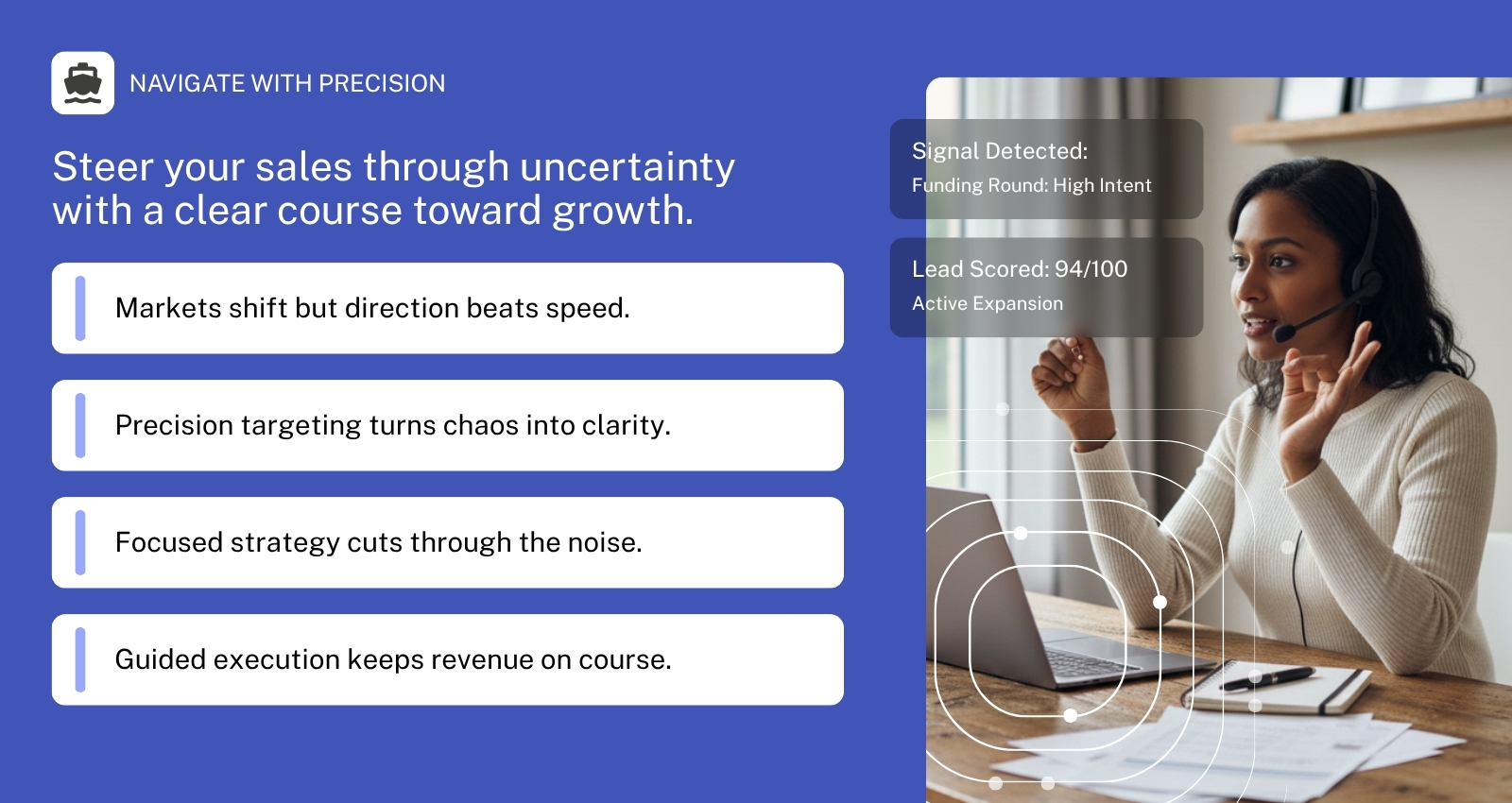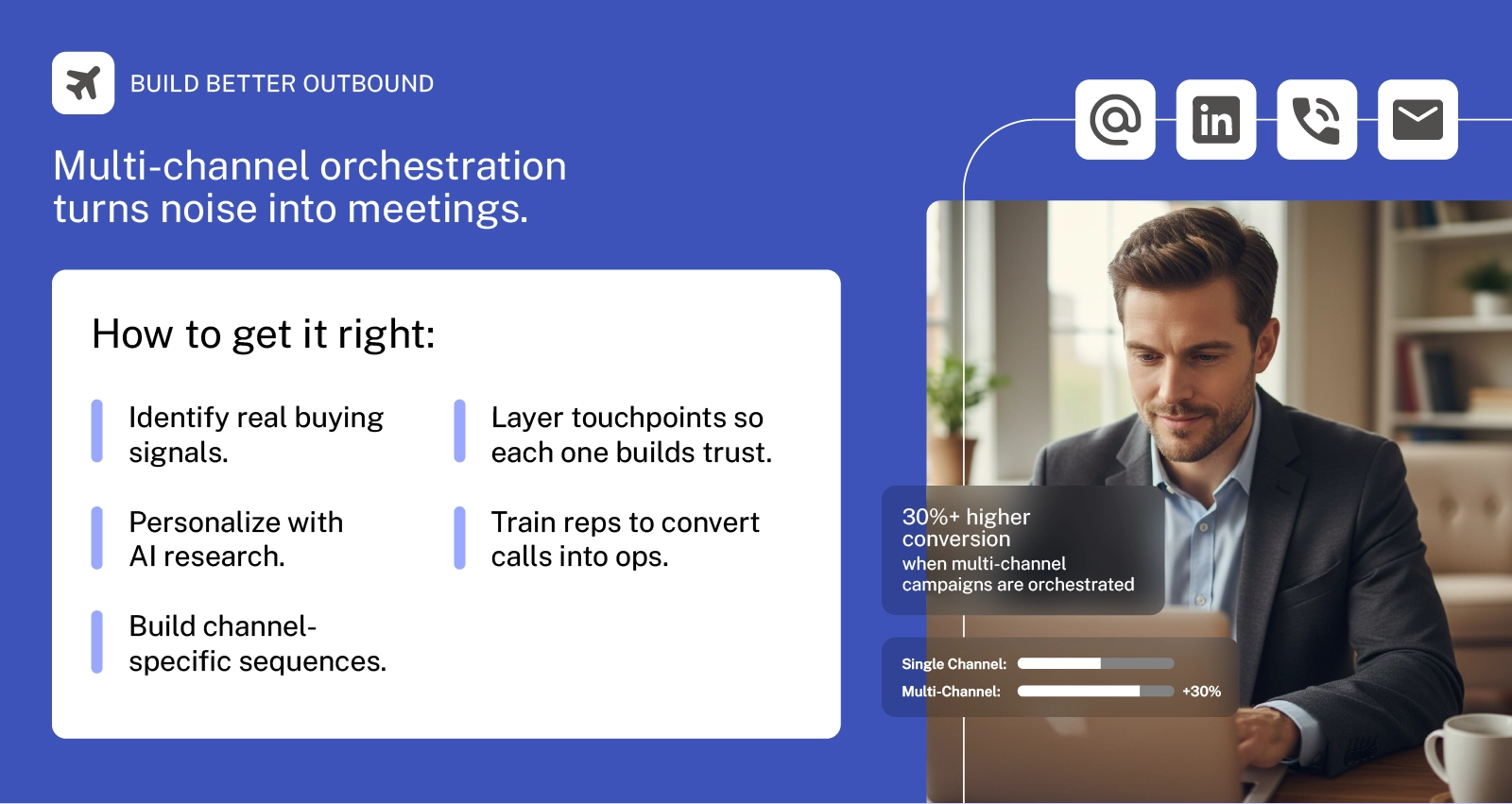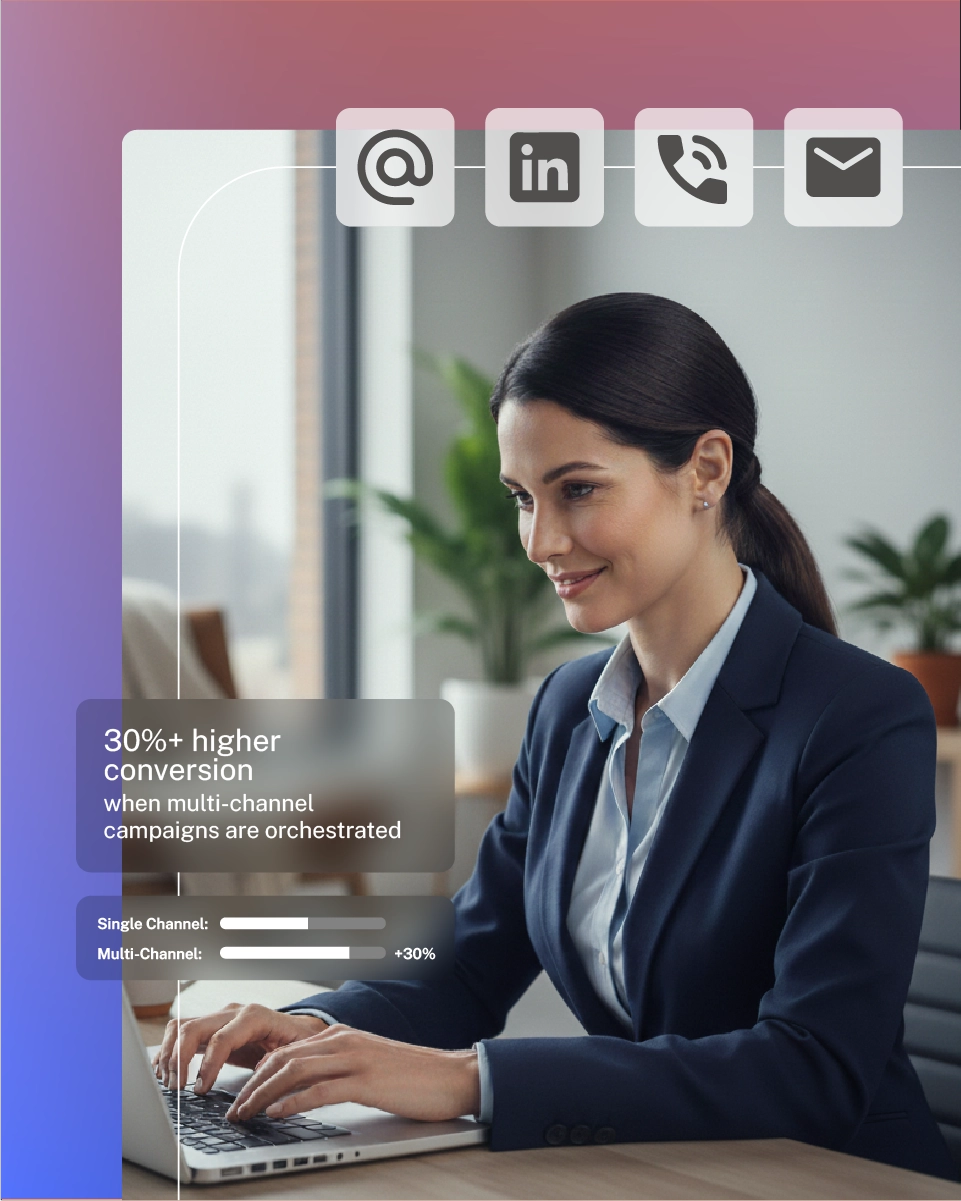

How to Leverage Trigger Events for B2B Sales Success
[blog_at_glance]
Remember that time you impulse-bought a gym membership in January? Yeah, that's a trigger event in action. (Don't worry, we've all been there. My unused yoga mat is judging me as we speak.)
But in B2B sales, trigger events are less about New Year's resolutions and more about spotting golden opportunities to swoop in and save the day with your product or service. It's like being a superhero, but instead of a cape, you're wearing a perfectly tailored suit.
Table of contents
- What is a Trigger Event Anyway?
- Why Should You Care?
- Sources of Trigger Events
- Automating Your Trigger Event Hunt
- Using Trigger Events Like a Boss
- The Step-by-Step Guide
- The Bottom Line
What is a Trigger Event Anyway?
A trigger event is basically anything that happens to a company that might make them more likely to buy your stuff. It's like when your neighbour gets a new car, and suddenly you're eyeing your beat-up sedan with disdain. Except in this case, it's more like when a company gets a new CEO, and suddenly they're eyeing their outdated software with disdain.
There are a few different types of trigger events:
- Account-level events:
This is stuff that happens to a specific company. Like when they hire a new CMO who's all about digital transformation. (Cue the "We need to innovate!" speeches.) - Market-level events:
These are bigger picture things that affect a whole industry. Like when GDPR dropped and every company scrambled to become compliant. (Remember those frantic "We've updated our privacy policy" emails? Good times.) - Middle-ground events:
These fall somewhere in between. Like when a competitor launches a game-changing product and everyone else is left scrambling to catch up. - 1st party events:
This is when someone interacts directly with your company. Like when they visit your website or download a whitepaper. (Pro tip: If they're downloading your whitepaper at 2 AM, they're either really interested or really bored. Either way, it's an opportunity.) - 2nd party events:
This is when someone engages with your content or community. Like when they comment on your LinkedIn post or join your Slack channel. - 3rd party events:
These are external events that you find out about through other sources. Like M&A activity, growth spurts, or new regulations.
Why Should You Care?
Back in my early sales days, I was struggling to hit my quota. I was cold calling like a madman, sending out generic emails, and basically throwing spaghetti at the wall to see what stuck.
Then, one day, I stumbled upon a LinkedIn post from a potential client. They were complaining about a problem that our product could solve. It was like the heavens opened up and the sales gods smiled upon me. I reached out with a personalised message addressing their specific issue, and boom! Meeting booked, deal closed, commission check cashed.
That, my friends, is the power of trigger events. It's like having a crystal ball that tells you exactly when a prospect is ready to buy.
Sources of Trigger Events
Now that you're all jazzed up about trigger events, you're probably wondering where to find them. Don't worry, I've got you covered. Here are some go-to sources:
- LinkedIn Sales Navigator:
This is like the Swiss Army knife of sales tools. It's got everything you need to stalk... I mean, research your prospects. - Industry-specific regulatory bodies:
Boring? Maybe. Goldmine of information? Absolutely. (Just don't fall asleep reading FDA regulations.) - Competitor actions:
Keep your friends close and your enemies closer, right? Set up Google Alerts for your competitors. - Technographic information:
Find out what tech stack your prospects are using. It's like peeking into their digital underwear drawer. - Crunchbase:
For all your funding and M&A gossip needs. It's like TMZ for startups.
Some examples of juicy trigger events:
- Senior leadership changes (Time to butter up the new boss!)
- Mergers and acquisitions (Nothing says "We need new software" like two companies trying to merge their incompatible systems.)
- New headcount changes (More people = more problems = more opportunities for you to swoop in and save the day.)
- New product launches (Because every new product needs a supporting cast of tools and services.)
- Regulatory guideline changes (Nothing strikes fear into the hearts of executives like new compliance requirements.)
- Competitor product sunsetting (One man's trash is another man's treasure... or in this case, one company's abandoned customers are your new best friends.)

Automating Your Trigger Event Hunt
Now, I know what you're thinking. "This sounds great, but I barely have time to eat lunch, let alone stalk hundreds of companies." Fear not. Automation is here to save the day.
Here are some tools to make your life easier:
- Sales Navigator:
I know I mentioned it before, but it bears repeating. - Owler:
For all your company stalking needs. It's like having a personal gossip columnist for every company you're interested in. - ZoomInfo's Insight tool:
Because knowing is half the battle. (The other half is actually doing something with that knowledge, but we'll get to that.) - CommonRoom:
For keeping tabs on your community engagement. Because sometimes the best leads are right under your nose.
Pro tip: Set up automated alerts and updates. Aim for daily email digests with the latest info. It's like having a personal assistant, but without the awkward water cooler conversations.
Using Trigger Events Like a Boss
Alright, so you've got all this juicy info. Now what? Here's where the rubber meets the road, folks.
- Personalise, personalise, personalise:
And I don't mean that weak sauce "I noticed you live in London" stuff. Dig deeper. If they just launched a new product, congratulate them and ask about the challenges they faced. Show that you've done your homework. - Find unique angles:
Everyone and their mother is sending "Congrats on the new role!" messages. Stand out by mentioning a specific challenge they might be facing in their new position. - Be human:
Remember, you're not a robot. Inject some personality into your outreach. Share a relevant anecdote or crack a (appropriate) joke. - Timing is everything:
Don't wait too long to reach out after a trigger event. Strike while the iron is hot, as they say. (But maybe wait a day or two after a mass layoff announcement. Read the room, people.)

The Step-by-Step Guide to Trigger Event Domination
- Define your Ideal Customer Profile (ICP):
Who's your perfect customer? Get specific. We're talking industry, company size, tech stack, the works. - Identify relevant trigger events:
What events would make your ICP more likely to buy? Make a list. Check it twice. - Find your sources:
Where can you find info on these events? Set up your listening posts. - Automate, automate, automate:
Use tools to gather this info automatically. Your future self will thank you. - Develop your game plan:
How will you use this info? Create templates, but keep them flexible enough to personalise.
The Bottom Line
Leveraging trigger events in B2B sales is like having a superpower. It's the difference between shouting into the void and whispering into the ear of someone who's actually interested in what you have to say.
But remember, with great power comes great responsibility. Don't be creepy, don't be pushy, and don't send generic "I noticed you breathe oxygen" messages.
Use trigger events to start genuine conversations, offer real value, and build lasting relationships. Because at the end of the day, that's what sales is all about. (Well, that and crushing your quota. Let's be real.)



“I focus on leading the direction of the business to maximise team efficiency and ensure client success”
[blog_at_glance]
Remember that time you impulse-bought a gym membership in January? Yeah, that's a trigger event in action. (Don't worry, we've all been there. My unused yoga mat is judging me as we speak.)
But in B2B sales, trigger events are less about New Year's resolutions and more about spotting golden opportunities to swoop in and save the day with your product or service. It's like being a superhero, but instead of a cape, you're wearing a perfectly tailored suit.
Table of contents
- What is a Trigger Event Anyway?
- Why Should You Care?
- Sources of Trigger Events
- Automating Your Trigger Event Hunt
- Using Trigger Events Like a Boss
- The Step-by-Step Guide
- The Bottom Line
What is a Trigger Event Anyway?
A trigger event is basically anything that happens to a company that might make them more likely to buy your stuff. It's like when your neighbour gets a new car, and suddenly you're eyeing your beat-up sedan with disdain. Except in this case, it's more like when a company gets a new CEO, and suddenly they're eyeing their outdated software with disdain.
There are a few different types of trigger events:
- Account-level events:
This is stuff that happens to a specific company. Like when they hire a new CMO who's all about digital transformation. (Cue the "We need to innovate!" speeches.) - Market-level events:
These are bigger picture things that affect a whole industry. Like when GDPR dropped and every company scrambled to become compliant. (Remember those frantic "We've updated our privacy policy" emails? Good times.) - Middle-ground events:
These fall somewhere in between. Like when a competitor launches a game-changing product and everyone else is left scrambling to catch up. - 1st party events:
This is when someone interacts directly with your company. Like when they visit your website or download a whitepaper. (Pro tip: If they're downloading your whitepaper at 2 AM, they're either really interested or really bored. Either way, it's an opportunity.) - 2nd party events:
This is when someone engages with your content or community. Like when they comment on your LinkedIn post or join your Slack channel. - 3rd party events:
These are external events that you find out about through other sources. Like M&A activity, growth spurts, or new regulations.
Why Should You Care?
Back in my early sales days, I was struggling to hit my quota. I was cold calling like a madman, sending out generic emails, and basically throwing spaghetti at the wall to see what stuck.
Then, one day, I stumbled upon a LinkedIn post from a potential client. They were complaining about a problem that our product could solve. It was like the heavens opened up and the sales gods smiled upon me. I reached out with a personalised message addressing their specific issue, and boom! Meeting booked, deal closed, commission check cashed.
That, my friends, is the power of trigger events. It's like having a crystal ball that tells you exactly when a prospect is ready to buy.
Sources of Trigger Events
Now that you're all jazzed up about trigger events, you're probably wondering where to find them. Don't worry, I've got you covered. Here are some go-to sources:
- LinkedIn Sales Navigator:
This is like the Swiss Army knife of sales tools. It's got everything you need to stalk... I mean, research your prospects. - Industry-specific regulatory bodies:
Boring? Maybe. Goldmine of information? Absolutely. (Just don't fall asleep reading FDA regulations.) - Competitor actions:
Keep your friends close and your enemies closer, right? Set up Google Alerts for your competitors. - Technographic information:
Find out what tech stack your prospects are using. It's like peeking into their digital underwear drawer. - Crunchbase:
For all your funding and M&A gossip needs. It's like TMZ for startups.
Some examples of juicy trigger events:
- Senior leadership changes (Time to butter up the new boss!)
- Mergers and acquisitions (Nothing says "We need new software" like two companies trying to merge their incompatible systems.)
- New headcount changes (More people = more problems = more opportunities for you to swoop in and save the day.)
- New product launches (Because every new product needs a supporting cast of tools and services.)
- Regulatory guideline changes (Nothing strikes fear into the hearts of executives like new compliance requirements.)
- Competitor product sunsetting (One man's trash is another man's treasure... or in this case, one company's abandoned customers are your new best friends.)

Automating Your Trigger Event Hunt
Now, I know what you're thinking. "This sounds great, but I barely have time to eat lunch, let alone stalk hundreds of companies." Fear not. Automation is here to save the day.
Here are some tools to make your life easier:
- Sales Navigator:
I know I mentioned it before, but it bears repeating. - Owler:
For all your company stalking needs. It's like having a personal gossip columnist for every company you're interested in. - ZoomInfo's Insight tool:
Because knowing is half the battle. (The other half is actually doing something with that knowledge, but we'll get to that.) - CommonRoom:
For keeping tabs on your community engagement. Because sometimes the best leads are right under your nose.
Pro tip: Set up automated alerts and updates. Aim for daily email digests with the latest info. It's like having a personal assistant, but without the awkward water cooler conversations.
Using Trigger Events Like a Boss
Alright, so you've got all this juicy info. Now what? Here's where the rubber meets the road, folks.
- Personalise, personalise, personalise:
And I don't mean that weak sauce "I noticed you live in London" stuff. Dig deeper. If they just launched a new product, congratulate them and ask about the challenges they faced. Show that you've done your homework. - Find unique angles:
Everyone and their mother is sending "Congrats on the new role!" messages. Stand out by mentioning a specific challenge they might be facing in their new position. - Be human:
Remember, you're not a robot. Inject some personality into your outreach. Share a relevant anecdote or crack a (appropriate) joke. - Timing is everything:
Don't wait too long to reach out after a trigger event. Strike while the iron is hot, as they say. (But maybe wait a day or two after a mass layoff announcement. Read the room, people.)

The Step-by-Step Guide to Trigger Event Domination
- Define your Ideal Customer Profile (ICP):
Who's your perfect customer? Get specific. We're talking industry, company size, tech stack, the works. - Identify relevant trigger events:
What events would make your ICP more likely to buy? Make a list. Check it twice. - Find your sources:
Where can you find info on these events? Set up your listening posts. - Automate, automate, automate:
Use tools to gather this info automatically. Your future self will thank you. - Develop your game plan:
How will you use this info? Create templates, but keep them flexible enough to personalise.
The Bottom Line
Leveraging trigger events in B2B sales is like having a superpower. It's the difference between shouting into the void and whispering into the ear of someone who's actually interested in what you have to say.
But remember, with great power comes great responsibility. Don't be creepy, don't be pushy, and don't send generic "I noticed you breathe oxygen" messages.
Use trigger events to start genuine conversations, offer real value, and build lasting relationships. Because at the end of the day, that's what sales is all about. (Well, that and crushing your quota. Let's be real.)















